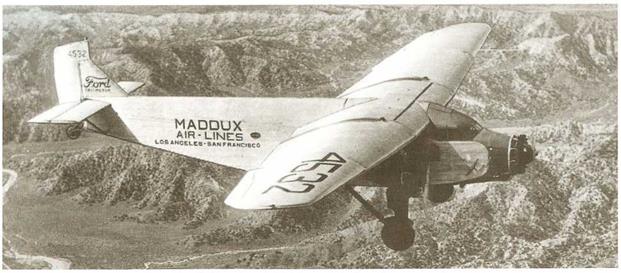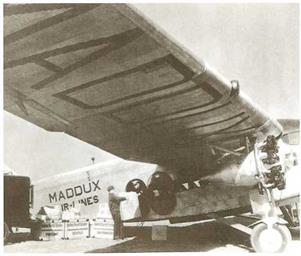Maddux Air Lines

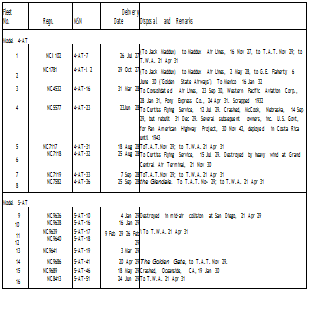
Jack Maddux
Harris Hanshue’s Western Air Express and Jack Frye’s Standard Airlines were not the only airlines of substance among the many which recognized the possible potential for airline operations in the booming California of the late 1920s. Jack L. Maddux, a Los Angeles Lincoln car dealer, took delivery of a Ford 4-AT Tri-Motor and incorporated Maddux Air Lines on 9 September 1927. His activities were overshadowed by other events, not least by Charles Lindbergh’s historic trans-Atlantic flight in May of that year and the Goodwill Tour of the 48 States that followed. Maddux’s contribution to the development of the airline business in the West has long been under-recognized, except by historians such as Ed Betts and Bill Larkins, whose research has preserved the memory of the Maddux operation.
Service Begins
Maddux began airline service on 1 November 1929 from Rogers Field, Los Angeles, to San Diego. He did it in style. For the occasion, Lindbergh was the honorary chief pilot. But like most of the aspirant airlines in California, he had no mail contract to supplement the passenger revenues. Nevertheless, he was very successful and popular. On 15 November, he added service to Agua Caliente, just across the Mexican
MADDUX AIR ONES FORD TRI-MOTORS
|
|
|
 |
|||||||||||||
|
|||||||||||||
|
|||||||||||||
|
|||||||||||||
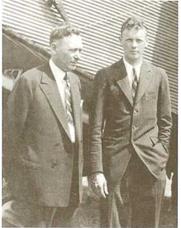
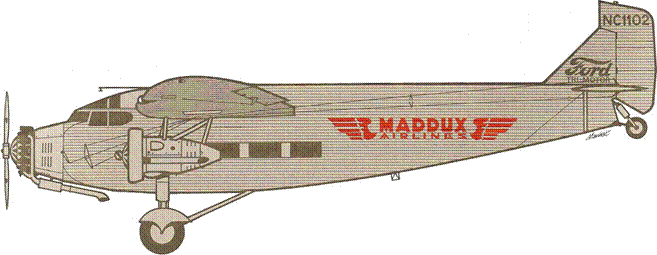
![]()


border, for thirsty Prohibition sufferers and for clients of the race-track and casinos there. On 14 April 1928, he started a twice-daily service from Los Angeles to San Francisco (Oakland), with optional stops at Bakersfield, Visalia, and Fresno. By the end of the year, his fleet comprised eight Fords, two Lockheed Vegas, and two Travel Airs.
Ford Promotion
Maddux began 1929 in style, adding a daily service to Phoenix (paralleling Standard), together with some local routes in California. Early in the year, the San Francisco terminus was transferred to Alameda, and the Los Angeles terminus to Glendale. Jack Maddux had assembled the largest fleet of Ford Tri-Motors, eight 4-ATs and eight 5-ATs plus two Lockheed Vegas. The only loss was when an Army pilot, doing some stunt flying, hit a 5-AT in mid-air. Maddux had not apparently sought an air mail contract, but his 16 pilots carried 40,000 passengers in 1929.
Historic Merger
In the summer, he started to negotiate with the new well-capitalized T. A.T., which began its highly-publicized coast-to-coast air-rail service on 7 July. Charles Lindbergh flew the inaugural flights for both airlines. Another important Maddux employee was Vice-president of Operations Lt. D. W. ‘Tommy’ Tomlinson, an ex-Navy pilot, and who was to play a key role in subsequent developments, when on 16 November 1929, Jack Maddux merged with T. A.T. and became president of the combined airline. T. A.T.-Maddux. Through this merger, T. A.T. was able to serve the two big Californian cities. Los Angeles and San Francisco, both growing quickly in population, wealth, and consequent travel potential.
The Ford Tri-Motors Compared
 |
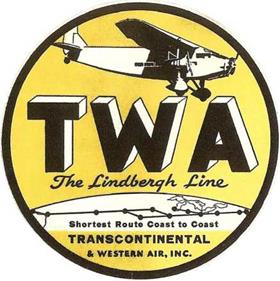
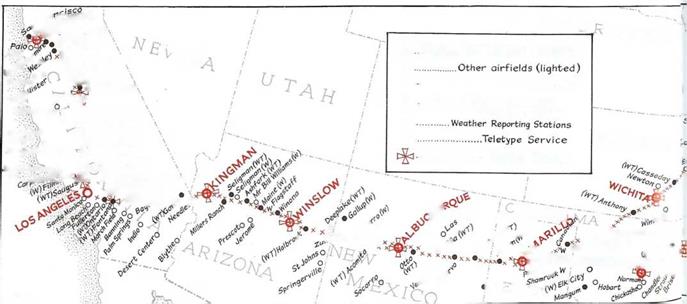
Consolidation of a Great Airline
Postmaster General Brown’s analytical planning had produced a fine transcontinental route. The Maddux merger had given T. A.T. direct service to all three of the large urban concentrations in California. But the formation of T. W.A. had been a complicated affair, because Pittsburgh Aviation Industries Corporation (P. A.I. C.) had started service from Pittsburgh to New York, via Philadelphia, with two Travel Airs, in December 1929, and had staked its claim. The threat to Brown’s master plan was neatly solved by dividing the stock of the merged company in the ratio 47.5% T. A.T., 47.5% W. A.E., and 5% P. A.I. C. After a legal delicacy, with the formation of the Eton Corporation on 19 July 1930, Transcontinental & Western Air (T. W.A.) was formed five days later. The coveted mail contract was awarded on 25 August. Although Harris Hanshue was made president of the new company, he quickly became disillusioned. R. W. Robbins, of P. A.I. C., took over the presidency in September 1931. Another contender, a group called United Avigation, was disposed of by the offer of a lucrative mail contract on a route sub-leased from American Airways.
End of the Air-Rail
With the completion of the Lighted Airway, and the improvement of aircraft reliability, the pioneering air-rail service came to an end. On 25 October 1930, the train connections were dropped and the Fords flew the whole route, coast-to-coast, in 36 hours, with an overnight stop at Kansas City. On 5 November 1932, even the overnight stop was dropped and the Fords flew by day and by night. Nevertheless the journey must have been arduous. The Ford’s engines were noisy, and passengers were issued ear plugs and chewing gum. Another development had been the shipment of livestock on 6 August 1931, one of the first examples of air freighting in the United States.
Superb Planning
All this was achieved only by some masterly planning. This is well illustrated by the map on this double-page spread, based on an original blueprint, signed by Jack Frye, but undoubtedly the work of T. W.A.’s technical consultant, Charles Lindbergh, who carried out the detailed surveys. He had a personal aircraft for the arduous travelling involved, and was paid $10,000 per year (a tidy sum in those days) plus 25,000 shares of T. W.A. stock, sold at well below market value.
|
|
|
|
|
|
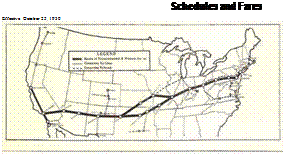 |
|
|
|
|
|
|
|
|
|
|
|












